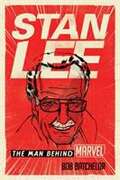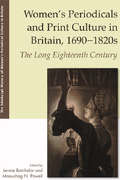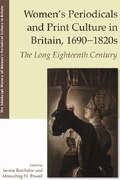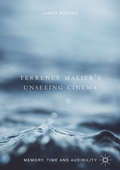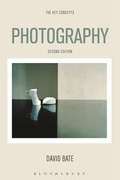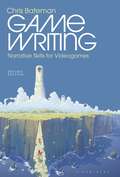- Table View
- List View
The Loss of Small White Clouds: Dementia in Contemporary Performance (Routledge Series in Equity, Diversity, and Inclusion in Theatre and Performance)
by Morgan BatchThis volume seeks to instigate a discussion about dementia in theatre. The discussions in this book borrow from the literature on dementia’s representation in other artforms, while reflecting on theatre’s unique capacity to incorporate multiple artforms in a live context (hypermediacy). The author examines constructions of diegesis and the use of various performance tools, including physical theatre, puppetry, and postdramatic performance. She discusses stage representations of interior experiences of dementia; selfhood in dementia; the demarcation of those with dementia from those without; endings, erasure, and the pursuit of catharsis; placelessness and disruptions of traditional dramatic constructions of time; and ultimately, performances creatively led by people with dementia. The book traces patterns of narrativisation on the stage—including common dramaturgical forms, settings, and character relationships—as well as examples that transcend mainstream representation. This book is important reading for theatre and performance students, scholars, and practitioners, as well as cultural studies writers engaged in research about narratives of dementia.
The Loss of Small White Clouds: Dementia in Contemporary Performance (Routledge Series in Equity, Diversity, and Inclusion in Theatre and Performance)
by Morgan BatchThis volume seeks to instigate a discussion about dementia in theatre. The discussions in this book borrow from the literature on dementia’s representation in other artforms, while reflecting on theatre’s unique capacity to incorporate multiple artforms in a live context (hypermediacy). The author examines constructions of diegesis and the use of various performance tools, including physical theatre, puppetry, and postdramatic performance. She discusses stage representations of interior experiences of dementia; selfhood in dementia; the demarcation of those with dementia from those without; endings, erasure, and the pursuit of catharsis; placelessness and disruptions of traditional dramatic constructions of time; and ultimately, performances creatively led by people with dementia. The book traces patterns of narrativisation on the stage—including common dramaturgical forms, settings, and character relationships—as well as examples that transcend mainstream representation. This book is important reading for theatre and performance students, scholars, and practitioners, as well as cultural studies writers engaged in research about narratives of dementia.
Intelligent Image Processing in Prolog
by Bruce G. BatchelorAfter a slow and somewhat tentative beginning, machine vision systems are now finding widespread use in industry. So far, there have been four clearly discernible phases in their development, based upon the types of images processed and how that processing is performed: (1) Binary (two level) images, processing in software (2) Grey-scale images, processing in software (3) Binary or grey-scale images processed in fast, special-purpose hardware (4) Coloured/multi-spectral images Third-generation vision systems are now commonplace, although a large number of binary and software-based grey-scale processing systems are still being sold. At the moment, colour image processing is commercially much less significant than the other three and this situation may well remain for some time, since many industrial artifacts are nearly monochrome and the use of colour increases the cost of the equipment significantly. A great deal of colour image processing is a straightforward extension of standard grey-scale methods. Industrial applications of machine vision systems can also be sub divided, this time into two main areas, which have largely retained distinct identities: (i) Automated Visual Inspection (A VI) (ii) Robot Vision (RV) This book is about a fifth generation of industrial vision systems, in which this distinction, based on applications, is blurred and the processing is marked by being much smarter (i. e. more "intelligent") than in the other four generations.
Interactive Image Processing for Machine Vision
by Bruce G. Batchelor Frederick WaltzMachine vision systems offer great potential in a large number of areas of manufacturing industry and are used principally for Automated Visual Inspection and Robot Vision. This publication presents the state of the art in image processing. It discusses techniques which have been developed for designing machines for use in industrial inspection and robot control, putting the emphasis on software and algorithms. A comprehensive set of image processing subroutines, which together form the basic vocabulary for the versatile image processing language IIPL, is presented. This language has proved to be extremely effective, working as a design tool, in solving numerous practical inspection problems. The merging of this language with Prolog provides an even more powerful facility which retains the benefits of human and machine intelligence. The authors bring together the practical experience and the picture material from a leading industrial research laboratory and the mathematical foundations necessary to understand and apply concepts in image processing. Interactive Image Processing is a self-contained reference book that can also be used in graduate level courses in electrical engineering, computer science and physics.
Intelligent Vision Systems for Industry
by Bruce G. Batchelor Paul F. WhelanThe application of intelligent imaging techniques to industrial vision problems is an evolving aspect of current machine vision research. Machine vision is a relatively new technology, more concerned with systems engineering than with computer science, and with much to offer the manufacturing industry in terms of improving efficiency, safety and product quality. Beginning with an introductory chapter on the basic concepts, the authors develop these ideas to describe intelligent imaging techniques for use in a new generation of industrial imaging systems. Sections cover the application of AI languages such as Prolog, the use of multi-media interfaces and multi-processor systems, external device control, and colour recognition. The text concludes with a discussion of several case studies that illustrate how intelligent machine vision techniques can be used in industrial applications.
Intelligent Machine Vision: Techniques, Implementations and Applications
by Bruce Batchelor Frederick WaltzA number of important aspects of intelligent machine vision in one volume, describing the state of the art and current developments in the field, including: fundamentals of 'intelligent'image processing for machine vision systems; algorithm optimisation; implementation in high-speed electronic digital hardware; implementation in an integrated high-level software environment and applications for industrial product quality and process control. Backed by numerous illustrations, created using the authors IP software, this book will be of interest to researchers in the field of machine vision wishing to understand the discipline and develop new techniques. Also useful for under- and postgraduates.
Colour (Documents Of Contemporary Art Ser.)
by David BatchelorThis chronological anthology reflects on the aesthetic, cultural and philosophical meaning of colour to artists within the broader context of anthropology, film, philosophy and science. Those who loathe colour have had as much to say as those who love it. Establishing colour as a central theme in the story of modern art, this is an indispensable handbook to the definitions and debates around its history, meaning and use.
Jane Austen Embroidery: Authentic Embroidery Projects For Modern Stitchers
by Jennie Batchelor Alison Larkin15 beautiful embroidery projects from the era of Jane Austen.
Women's Periodicals and Print Culture in Britain, 1690-1820s: The Long Eighteenth Century
by Jennie Batchelor Manushag N. PowellDefinitive modern edition of Stevenson’s intriguing account of his emigration from Scotland to California
Women's Periodicals and Print Culture in Britain, 1690-1820s: The Long Eighteenth Century (The\edinburgh History Of Women's Periodical Culture In Britain Ser.)
by Jennie Batchelor Manushag N. PowellExamines the practices of independent digital feature-filmmaking in contemporary Britain
Lady Trevelyan and the Pre-Raphaelite Brotherhood
by John BatchelorAn entertaining account of an extraordinary cultural and historical event: - the establishment by one highly intelligent woman of a salon of the arts in a beautiful country house in Northumberland. Wallington Hall was remote from the major centres of artistic activity, such as London and Edinburgh. Yet Pauline Trevelyan single handedly made it the focus of High Victorian cultural life. Among those she attracted into her orbit were Ruskin, Swinburne, the Brownings, the Rossettis (Dante Gabriel, Christina and William Michael), Carlyle, and Millais and other members of the Pre-Raphaelite Brotherhood.The penniless but clever daughter of a clergyman, Pauline Jermyn married an older man whom she met through a shared passion for geology. Sir Walter Trevelyan was a philanthropist, teetotal, vegetarian, pacificist ... and very rich. With his encouragement, she collected works of art and decorated Wallington Hall with a cycle of vast paintings on the history of Northumberland. She was a patron of the arts who provided a fostering environment for many of the geniuses of her day. After her death, Swinburne wept every time her name was mentioned.
Terrence Malick’s Unseeing Cinema: Memory, Time And Audibility
by James BatchoThis unique study opens up a new dimension of Terrence Malick’s cinema – its expressions of unseeing and hearing. ‘Unseeing’ is Malick’s means of transcending the moment in order to enter the life that unfolds; to treat cinema as a real experience for those who live its reality. In this way, Terrence Malick’s Unseeing Cinema moves beyond film theory to advance a work of original philosophy, bringing together two thinkers not normally associated with one another: Gilles Deleuze and Søren Kierkegaard. It investigates how Malick’s gatherings of time allow one to explore new philosophical questions about immanence and transcendence, ethics and faith, time and infinity, and the foldings of subjectivity that are central to both philosophers. Beyond cinema, it offers a way to think about our everyday repetitions and recollections and our ephemeral points of connection with those we love.
Terrence Malick’s Unseeing Cinema: Memory, Time and Audibility
by James BatchoThis unique study opens up a new dimension of Terrence Malick’s cinema – its expressions of unseeing and hearing. ‘Unseeing’ is Malick’s means of transcending the moment in order to enter the life that unfolds; to treat cinema as a real experience for those who live its reality. In this way, Terrence Malick’s Unseeing Cinema moves beyond film theory to advance a work of original philosophy, bringing together two thinkers not normally associated with one another: Gilles Deleuze and Søren Kierkegaard. It investigates how Malick’s gatherings of time allow one to explore new philosophical questions about immanence and transcendence, ethics and faith, time and infinity, and the foldings of subjectivity that are central to both philosophers. Beyond cinema, it offers a way to think about our everyday repetitions and recollections and our ephemeral points of connection with those we love.
Art Photography (PDF)
by David BateThe last few decades have seen a huge growth in interest in photography and its role in contemporary art. This relatively recent art form is now recognised as central to modern art exhibition and practice. In this book David Bate introduces the key themes through selected visual examples and references to contemporary debates and issues, while also providing a historical overview. Featuring works from a wide and international selection of artists, the book includes conceptual and post-conceptual work, documentary photography, archives and social networks, and performance. It focuses on the increasingly global nature of the field, not just the Anglo-American/European context, but also the important emerging regions of Asia, Africa and the Middle East. This is an essential introductory guide to thinking about photography in its relation to contemporary art from a leading writer in the field.
Photography: The Key Concepts, (2nd edition) (PDF)
by David BateProviding a thorough and comprehensive introduction to the study of photography, this second edition of Photography: The Key Concepts has been expanded and updated to cover more fully contemporary changes to photography. Photography is a part of everyday life; from news and advertisements, to data collection and surveillance, to the shaping of personal and social identity, we are constantly surrounded by the photographic image. Outlining an overview of photographic genres, David Bate explores how these varied practices can be coded and interpreted using key theoretical models. Building upon the genres included in the first edition - documentary, portraiture, landscape, still life, art and global photography - this second edition includes two new chapters on snapshots and the act of looking. The revised and expanded chapters are supported by over three times as many photographs as in the first edition, examining contemporary practices in more detail and equipping students with the analytical skills they need, both in their academic studies and in their own practical work. An indispensable guide to the field, Photography: The Key Concepts is core reading for all courses that consider the place of photography in society, within photographic practice, visual culture, art, media and cultural studies.
Photography: The Key Concepts
by David BateProviding a thorough and comprehensive introduction to the study of photography, this second edition of Photography: The Key Concepts has been expanded and updated to cover more fully contemporary changes to photography. Photography is a part of everyday life; from news and advertisements, to data collection and surveillance, to the shaping of personal and social identity, we are constantly surrounded by the photographic image. Outlining an overview of photographic genres, David Bate explores how these varied practices can be coded and interpreted using key theoretical models. Building upon the genres included in the first edition – documentary, portraiture, landscape, still life, art and global photography – this second edition includes two new chapters on snapshots and the act of looking. The revised and expanded chapters are supported by over three times as many photographs as in the first edition, examining contemporary practices in more detail and equipping students with the analytical skills they need, both in their academic studies and in their own practical work.An indispensable guide to the field, Photography: The Key Concepts is core reading for all courses that consider the place of photography in society, within photographic practice, visual culture, art, media and cultural studies.
Photography: The Key Concepts (The\key Concepts Ser.)
by David BateProviding a thorough and comprehensive introduction to the study of photography, this second edition of Photography: The Key Concepts has been expanded and updated to cover more fully contemporary changes to photography. Photography is a part of everyday life; from news and advertisements, to data collection and surveillance, to the shaping of personal and social identity, we are constantly surrounded by the photographic image. Outlining an overview of photographic genres, David Bate explores how these varied practices can be coded and interpreted using key theoretical models. Building upon the genres included in the first edition – documentary, portraiture, landscape, still life, art and global photography – this second edition includes two new chapters on snapshots and the act of looking. The revised and expanded chapters are supported by over three times as many photographs as in the first edition, examining contemporary practices in more detail and equipping students with the analytical skills they need, both in their academic studies and in their own practical work.An indispensable guide to the field, Photography: The Key Concepts is core reading for all courses that consider the place of photography in society, within photographic practice, visual culture, art, media and cultural studies.
Photography after Postmodernism: Barthes, Stieglitz and the Art of Memory
by David BateIn life after postmodernism our conception of photography is not the same as before. Photography After Postmodernism starts with this conception and explores what changes have affected photography, its relation to social life and our image-centred culture. Engaging with the visual environment and issues that have emerged in the postmodern world, David Bate introduces fresh approaches and analysis of photographs and their place within the aftermath of postmodernist thought. The book shows how photographs circulate in an 'image-world' beyond their art or media origins that deeply affects our sense of time and relation to memory. The role of archives, dreams, memories and time are deployed to develop and resituate arguments about photography made by Roland Barthes in Camera Lucida to further engage and understand our contemporary condition. By considering how ‘afterwardness’ is invoked in the developments of modern and contemporary photography, Bate demonstrates the complex ways in which photographic images resonate across public and private spaces, while carrying a slippage of meaning that is never quite fixed, yet always contingent and social. The approach shows how modernist photography was already invested in values that its discourse could not enunciate, which resonates with much contemporary photography today. Featuring a range of historical and contemporary images, the book offers detailed and innovative readings of specific photographs which open new avenues of thought for those studying and researching visual culture and photography.
Photography after Postmodernism: Barthes, Stieglitz and the Art of Memory
by David BateIn life after postmodernism our conception of photography is not the same as before. Photography After Postmodernism starts with this conception and explores what changes have affected photography, its relation to social life and our image-centred culture. Engaging with the visual environment and issues that have emerged in the postmodern world, David Bate introduces fresh approaches and analysis of photographs and their place within the aftermath of postmodernist thought. The book shows how photographs circulate in an 'image-world' beyond their art or media origins that deeply affects our sense of time and relation to memory. The role of archives, dreams, memories and time are deployed to develop and resituate arguments about photography made by Roland Barthes in Camera Lucida to further engage and understand our contemporary condition. By considering how ‘afterwardness’ is invoked in the developments of modern and contemporary photography, Bate demonstrates the complex ways in which photographic images resonate across public and private spaces, while carrying a slippage of meaning that is never quite fixed, yet always contingent and social. The approach shows how modernist photography was already invested in values that its discourse could not enunciate, which resonates with much contemporary photography today. Featuring a range of historical and contemporary images, the book offers detailed and innovative readings of specific photographs which open new avenues of thought for those studying and researching visual culture and photography.
Photography and Surrealism: Sexuality, Colonialism and Social Dissent
by David BateDavid Bate examines automatism and the photographic image, the Surrealist passion for insanity, ambivalent use of Orientalism, use of Sadean philosophy and the effect of fascism of the Surrealists. The book is illustrated wtih a wide range of surrealist photographs.
Photography and Surrealism: Sexuality, Colonialism and Social Dissent
by David BateDavid Bate examines automatism and the photographic image, the Surrealist passion for insanity, ambivalent use of Orientalism, use of Sadean philosophy and the effect of fascism of the Surrealists. The book is illustrated wtih a wide range of surrealist photographs.
Photography in the Great War: The Ethics of Emerging Medical Collections from the Great War (Facialities: Interdisciplinary Approaches to the Human Face)
by Jason BateThis book draws on a rich set of materials to examine postwar experiences of ex-servicemen who were facially-disfigured during the First World War. Weaving together medical, institutional, amateur and family photographic albums under a social history framework, Jason Bate underscores overlooked aspects of these men's continued hardships after returning home from the front. In particular, a focus is on the private sphere of the family and the complicated world of employment that disfigured veterans navigated on their return. Little attention has hitherto been paid to the aftercare of disfigured veterans once discharged from the army, or the long-term impact on individuals, and the sense of burden felt by families and local communities. In addressing this neglected area, the chapters here illuminate different practices of photography by doctors, nurses, press agencies, and families across the generations to challenge our perceptions of the personal traumas of soldiers and civilians.
Photography in the Great War: The Ethics of Emerging Medical Collections from the Great War (Facialities: Interdisciplinary Approaches to the Human Face)
by Jason BateThis book draws on a rich set of materials to examine postwar experiences of ex-servicemen who were facially-disfigured during the First World War. Weaving together medical, institutional, amateur and family photographic albums under a social history framework, Jason Bate underscores overlooked aspects of these men's continued hardships after returning home from the front. In particular, a focus is on the private sphere of the family and the complicated world of employment that disfigured veterans navigated on their return. Little attention has hitherto been paid to the aftercare of disfigured veterans once discharged from the army, or the long-term impact on individuals, and the sense of burden felt by families and local communities. In addressing this neglected area, the chapters here illuminate different practices of photography by doctors, nurses, press agencies, and families across the generations to challenge our perceptions of the personal traumas of soldiers and civilians.
Game Writing: Narrative Skills for Videogames
by Chris BatemanAs the videogame industry has grown up, the need for better stories and characters has dramatically increased, yet traditional screenwriting techniques alone cannot equip writers for the unique challenges of writing stories where the actions and decisions of a diverse range of players are at the centre of every narrative experience. Game Writing: Narrative Skills for Videogames was the first book to demystify the emerging field of game writing by identifying and explaining the skills required for creating videogame narrative.Through the insights and experiences of professional game writers, this revised edition captures a snapshot of the narrative skills employed in today's game industry and presents them as practical articles accompanied by exercises for developing the skills discussed. The book carefully explains the foundations of the craft of game writing, detailing all aspects of the process from the basics of narrative to guiding the player and the challenges of nonlinear storytelling. Throughout the book there is a strong emphasis on the skills developers and publishers expect game writers to know.This second edition brings the material up to date and adds four new chapters covering MMOs, script formats, narrative design for urban games, and new ways to think about videogame narrative as an art form. Suitable for both beginners and experienced writers, Game Writing is the essential guide to all the techniques of game writing. There's no better starting point for someone wishing to get into this exciting field, whether they are new game writers wishing to hone their skills, or screenwriters hoping to transfer their skills to the games industry.

